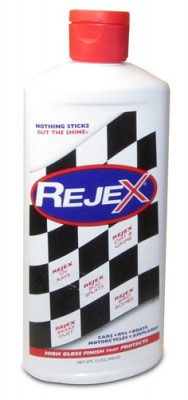
You can apply wax over the sealant if you wish. This is because bonds need to form between polymers on the surface your paint and the sealant. This means a lot less work for you! However, as a note of caution, you cannot apply paint sealer over wax.
REJEX POLYMER COATING REVIEW FULL
However, if it is applied correctly, most paint sealants will last for a full twelve months. The manufacturer will indicate how long each particular product will last. Paint sealants are designed to last for many months. Q: How often should I apply my paint sealant? The sealant must cure before you can apply another coat. This will prevent slinging.įor wipe on wipe off sealants, after 10 or 20 minutes (check the instructions) buff off left-over sealant by placing a microfiber cloth over the top of a new buffing pad. While the pad is still in contact with the paint, turn the buffer off. Select a high speed and work the sealant in at around five inches per second and overlap each pass. Select a low speed and spread the sealant evenly. With the machine off, use the pad to spread some car paint sealer around.

Here are the steps that you should follow to apply sealant using a dual action random orbital polisher.įit a fresh finishing pad to the machine.Īpply a couple of drops of sealant onto the finishing pad. Let the sealant cure before you apply another coat. This is usually between 10 and 20 minutes.įor wipe on wipe off sealants, you will have to buff excess sealant using a microfiber cloth. Leave the sealant in place for the period of time specified by the manufacturer.

You must cover all the paint so overlap each pass as you work across each panel of your car. Some people prefer a circular motion but others prefer a cross hatch. Make contact with the paint lightly and spread the sealant across the paint thinly. This should be made of foam or microfiber. Pour a few drops of sealant onto an applicator pad. Make sure that the paint surface that you are covering is completely clean. Here are the steps that you should follow to apply sealant by hand. Your main aim should be to apply it both thinly and uniformly. Sealants are liquids and are therefore very easy to work with. It can be applied by hand or you can use a machine. If you can put wax on then you will certainly be able to apply a sealant. You may be surprised at how easy a synthetic paint sealant is to apply. when bugs and other contaminants begin sticking to leading edges of wings and front bumpers, when brake dust begins sticking more tenatiously to wheels, etc.).Q: How do I apply a synthetic paint sealant? While it it not uncommon for a RejeX treatment to last well over a year, for optimum protection, reapply every 6 months or as needed (e.g.The higher the humidity, the faster RejeX cures. Allow RejeX to cure for 8-12 hours out of the elements.Unlike waxes that require strenuous rubbing or buffing to remove, RejeX should wipe off easily. After RejeX dries to a haze (about 10-20 minutes), wipe off with a clean cloth.On hot days, we recommend RejeXing in the shade, early morning or in the afternoon. Apply to a clean, dry surface that is cool to the touch. Avoid appling in direct sunlight when ambient temperatures are greater than 85° F.RejeX also provides exceptional UV protection.

This very thin film, only tenths of a micron thick, reduces adhesion of all common contaminants such as road grime, exhaust, oil, bug splats, bird droppings, brake dust, tree sap, pollen, tar and grease. The product dries water clear, and unlike wax-based products, never yellows. This highly durable coating produces a deep, lustrous shine that outlasts other products by months. RejeX has a higher refractive index than any wax, so it produces richer, deeper looking colors. RejeX is commonly used as a paint sealant providing a better performing alternative to wax-type products for owners who want to maximize protection and shine on vehicles of all sorts, including aircraft, cars, motorcycles, boats and RVs. RejeX® is a proprietary thin film polymer coating technology designed to provide a high-gloss / ultra-high-release surface.


 0 kommentar(er)
0 kommentar(er)
